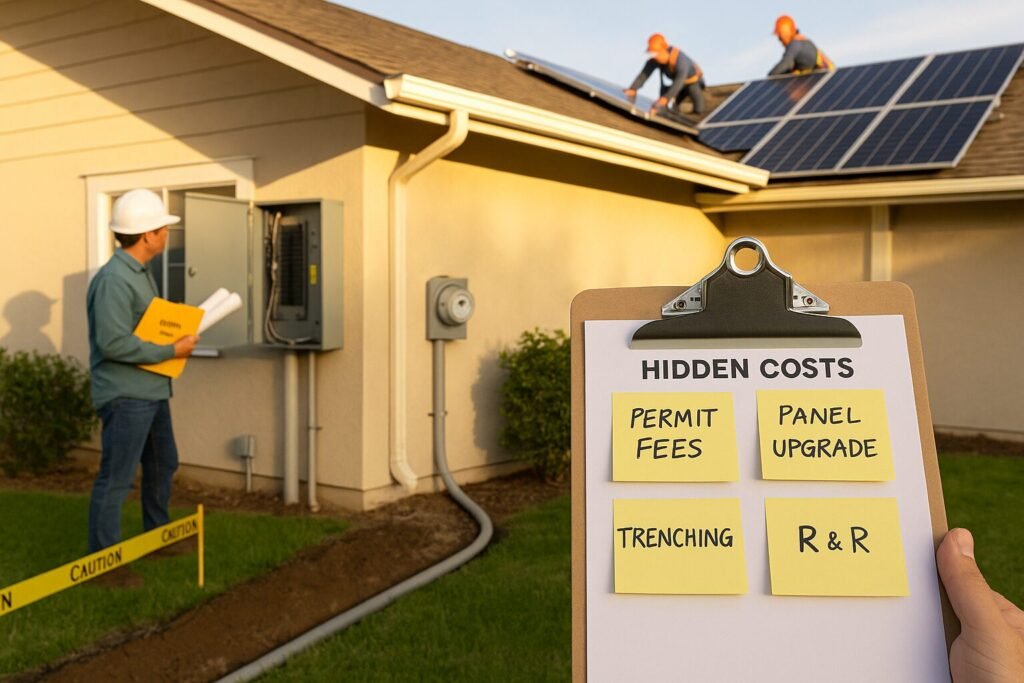Hidden Costs of Solar: Avoid Budget-Killing Surprises
See the real costs of going solar—panel upgrades, R&R, permits, fees, financing traps, and policy risks—plus scripts and checklists to protect your budget.
I love solar. But I’ve also seen “all-in” quotes turn into surprise invoices.
When I helped a neighbor here in Hawaii compare bids, the cheapest proposal ballooned after the site visit: a main service-panel upgrade, longer conduit run, and a utility meter change. None of it was in the first quote. That experience pushed me to create this guide—so you can spot the hidden costs of solar before you sign.
Use this like a field manual. Skim the TL;DR box, then jump to the sections that match your home. I’ll share the questions I ask installers, the red flags I look for, and simple steps to protect your budget.
TL;DR Snapshot (Skimmer Box)
- Panel upgrade? Ask for a written load calculation and a capped allowance for service work.
- Roof near end-of-life? Get remove & reinstall (R&R) pricing locked in now.
- Permits + utility fees: Request a line-item list. Who pays for resubmittals?
- Trenching & conduit: Demand a site map with measured runs before you sign.
- Production shortfalls: Get a performance guarantee with clear remedies.
- Monitoring & maintenance: Confirm lifetime portal access and who pays for truck rolls.
- Replacement horizon: Budget for inverter and battery swaps later.
- Insurance: Ask your insurer about premium changes and documentation.
- Financing: Watch for dealer fees, origination, and prepayment penalties.
- Leases/PPAs: Check escalators, buyout tables, and transfer rules.
- Policy risk: Stress-test ROI for TOU windows, export credits, and fixed charges.
What’s In vs. Out of Your Quote (Scope Map)
Quotes often look comprehensive but hide “exclusions” and “assumptions.” These become change orders later.
Common inclusions
- Modules, racking, inverter(s) or microinverters/optimizers
- Single roof plane wiring runs, standard attachments
- Standard permit and inspection coordination
Common exclusions
- Main service panel (MSP) upgrades or meter combos
- Roof repair/replacement or future R&R
- Trenching, hardscape/landscape restoration
- Structural engineering upgrades for wind/snow
- Utility interconnection fees and resubmittals
- Monitoring subscriptions, cellular gateways, and API access
- Pest abatement/critter guards, cleaning, and data SIM fees
Pro move: Ask for a scope matrix that lists each item as Included / Excluded / Allowance with dollar caps.
Electrical: Main Service Panel, Wiring & Interconnection
I always start here because electrical surprises are expensive.
When you might need an MSP upgrade
- Existing panel at capacity (no spaces, hot busbar)
- The 120% rule is exceeded with back-feed breakers
- Utility requires a meter/main combo or service relocation
- High continuous loads (EVs, heat pumps) push ampacity limits
Hidden cost drivers
- Panel size (e.g., 100A → 200A), service drop/conductor upgrades
- AFCI/GFCI requirements, relocation, stucco or masonry work
- Revenue-grade meters, current transformers (CTs), production meters
What to ask
- “Please include a written load calculation and interconnection method (line-side tap vs. breaker).”
- “If an MSP upgrade is needed, cap it at $X (allowance).”
- “List utility fees and whether you or the installer pays them.”
Roof Readiness & Future Reroof Costs
Panels can outlast shingles. If your roof is at the end of its life, consider replacing it before installation.
Key questions
- What’s the roof age and condition? (Get a roof inspection report.)
- Who warrants leak penetrations, and for how long?
- If I reroof later, what’s the R&R price—locked in writing?
Pro move: Ask the installer to include R&R labor pricing now. Future-you will be grateful.
Permits, Plan Review & Utility Interconnection Fees
Soft costs add up.
You might see
- City/county permit and plan-check fees
- Structural stamps when required
- Utility application, engineering study, inspection, and Permission to Operate (PTO) fees
Time traps
- Resubmittals after plan review comments
- Utility queue delays and re-inspection fees
What to ask
- “Provide a line-item list of all permit/plan/utility fees and who pays each.”
- “What’s the expected PTO date and who handles resubmittals?”
Trenching, Conduit Runs & Structural/Engineering Changes
After the site visit, real-world distances and obstacles appear.
Typical triggers
- Long conduit runs, difficult attic routes, stucco/concrete coring
- Trenching to detached garages or ground mounts
- Structural adds: purlin reinforcement, additional attachments, higher wind/snow requirements
What to ask
- “Attach a site map with measured conduit length and trench path.”
- “Include one free re-route if field conditions differ from drawings.”
- “List structural assumptions in the proposal.”
Production Reality: Shading, Soiling & Shortfalls
Models are optimistic. Real roofs are messy.
What dents production
- Seasonal shade paths, neighbor trees, chimneys, vent stacks
- Soiling (dust, salt spray, pollen), high temperature, and inverter clipping
- Performance ratio lower than modeled due to balance-of-system losses
Protect yourself
- Request the shade study (photos, heatmap, or horizon profile)
- Ask for module-level electronics (optimizers/microinverters) where shade is non-trivial
- Clarify the performance guarantee: baseline, exclusions, measurement method, and remedy (cash, extra panels, fixes)
Related read on MicroHomesteader: Clean Solar Panels to Boost Solar Efficiency and What Affects Solar Panel Efficiency?
Monitoring, Data Access & Ongoing Maintenance
I always check the monitoring fine print.
Look for
- Lifetime portal access (not just the first year)
- Cellular gateway fees vs. Wi-Fi
- API/export access if you like data
- Truck-roll rates for diagnostics, pest abatement, or firmware issues
Ask
- “Is monitoring included for the life of the system?”
- “Who pays for on-site labor during RMAs?”
- “What’s the annual inspection/cleaning price?”
Replacement Horizons: Inverters, Optimizers & Batteries
Panels often run 25+ years. Electronics don’t.
Typical lifespans (ballpark concepts, not quotes)
- String or microinverters: mid-teens to ~20 years
- DC optimizers: similar to inverter horizon
- Batteries: capacity degrades by throughput and time; plan a mid-life service or module swap
Warranty nuance
- Parts vs. labor
- Battery capacity retention (prorated)
- Who handles shipping and onsite work?
Plan a reserve
- Set aside a small future replacement fund earmarked for inverter/battery events.

Homeowners Insurance & Roof/Structural Coverage
Solar can change your policy details.
Expect conversations about
- Declared value and coverage limits
- Wind/hail/fire zones and premium adjustments
- Documenting roof penetrations and the installer’s leak warranty
Ask
- “Do you need a completion packet (as-builts, photos, invoice)?”
- “Will my premium change, and by how much?”
Financing Add-Ons: The “Dealer Fee” Trap
Zero-down looks great until you see the dealer fee quietly inflating the system price.
Watch for
- Dealer fees, origination, deferred interest
- Prepayment penalties or interest-accrual gotchas
- A higher “financed price” vs. “cash price”
Ask
- “What is the cash price vs. the financed price?”
- “What’s the exact dealer fee %?”
- “Can I prepay without penalty?”
Related read: Solar Loan vs Lease vs PPA: Best Option in 2025
Leases & PPAs: Escalators, Buyouts & Home Sale Transfers
Leases/PPAs can work for some homes, but the fine print decides your savings.
Key items
- Annual escalator (compounds over time)
- Buyout table (early and end-of-term)
- Transfer process when selling your home (credit checks, timelines, fees)
Ask
- “Show the buyout table and escalator in the contract.”
- “What’s your transfer success rate and average timeline?”
Policy Risk: Utility Rates, TOU Windows & Export Rules
Your savings depend on the rules of the game—and the game changes.
Risks to the model
- Time-of-Use (TOU) shifts that move peak periods later
- Lower net-metering/export credits
- New fixed charges or minimum bills
Protect yourself
- Ask the installer to stress-test ROI with a lower export rate and later TOU peak.
- Consider right-sizing and adding load shifting (heat-pump water heaters, batteries) if policy winds are shifting.
Related reads: Federal & State Solar Incentives (2025 Guide) and The Future of Solar Energy: What’s Coming in the Next 5 Years.
Contract Red-Flag Checklist
- ☐ Change-order rules and price caps stated
- ☐ Detailed inclusions/exclusions list
- ☐ Performance guarantee terms and remedy
- ☐ Monitoring terms and any subscription fees
- ☐ Warranty covers parts + labor (and leak warranty period)
- ☐ R&R pricing for future reroof (locked amount)
- ☐ Interconnection responsibilities + target PTO date
- ☐ Financing disclosures (dealer fee %, penalties)
- ☐ Lease/PPA escalator and buyout table attached
“Ask Your Installer”
- Please include a load calculation and identify the interconnection method.
- List all permit/plan/utility fees and who pays them.
- Attach a site map with measured conduit and trenching.
- Provide the shade study (images/heatmap) and expected performance ratio.
- Spell out the performance guarantee and the remedy if under-produced.
- Confirm lifetime monitoring and any cellular fees.
- Clarify warranty (parts and labor) and who handles RMAs/truck rolls.
- Lock R&R pricing for a future reroof in writing.
- Disclose dealer fee %, origination, and prepay rules.
- For leases/PPAs, include the escalator, buyout table, and transfer steps.
Example Scenarios (Mini Case Studies)
A. Roof at 18 years
Reroof now + solar once = no mid-life R&R cost and one set of penetrations. Waiting two years would have meant paying for R&R and risking schedule chaos.
B. 100A panel + EV on the way
Installer A ignored it; Installer B showed a load calc and capped an MSP upgrade. The “cheaper” bid wasn’t cheaper after the inevitable change order.
C. TOU shift & evening peaks
Modeling a later peak pushed the homeowner to add a small battery for load shifting. Savings were steadier even after export credits dropped.
Key Takeaways & Next Steps
- Surprises are optional. Most “gotchas” are visible if you know where to look.
- Demand specifics in writing. Load calcs, site maps, fee lists, and guarantees.
- Budget realistically. Include one-time adders, recurring costs, and future reserves.
- Stress-test your ROI: policy, TOU, and export credit changes—plan for them.
